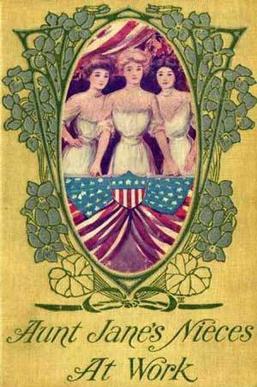Aunt Jane's Nieces at Work facts for kids

First edition
|
|
| Author | L. Frank Baum (as "Edith Van Dyne") |
|---|---|
| Illustrator | Emile A. Nelson |
| Country | United States |
| Language | English |
| Series | Aunt Jane's Nieces |
| Genre | Young adult fiction |
| Publisher | Reilly & Britton |
|
Publication date
|
1909 |
| Media type | Print (hardcover) |
| Pages | 298 pp. |
| Preceded by | Aunt Jane's Nieces at Millville |
| Followed by | Aunt Jane's Nieces in Society |
Aunt Jane's Nieces at Work is a book for young people, written in 1909 by L. Frank Baum. He's famous for creating the magical Land of Oz. This book is the fourth in his popular ten-book series called Aunt Jane's Nieces. It was one of his most successful series, right after his Oz books. Like other books in the series, it was published under the pen name "Edith Van Dyne." This was one of several fake names Baum used.
Contents
What's the Story About?
The story continues to follow three cousins: Louise Merrick, Beth De Graf, and Patsy Doyle. The title of the book is a bit tricky. It could really be called Aunt Jane's Nieces in Politics. This is because their Uncle John Merrick tells them that politics is "work."
Helping a Cousin Win
The story starts just three days after the last book, Aunt Jane's Nieces at Millville. Patsy, who has red hair and freckles, still has a sunburn from her summer trip. She and Louise get letters from their "cousin" Kenneth Forbes. Kenneth is the young man who inherited Aunt Jane's money in the first book.
Kenneth has decided to get involved in politics. He is running for a seat in the New York State Legislature. This is like a state government job. But Kenneth thinks he is going to lose the election. So, the whole family decides to help him win.
Campaigning for Kenneth
The cousins and Uncle John travel to the countryside where Kenneth's home, Elmhurst, is located. Uncle John is very rich. The three attractive girls and their two cars cause a big stir. Cars were not common in that area back then.
Patsy talks to local business owners to get their support. Beth writes articles for newspapers and press releases. Louise focuses on visiting the wives of local farmers. Women could not vote in 1909. But they could tell their husbands how to vote!
Uncle John also spends his money to help Kenneth. He even pays the local newspaper to write good things about Kenneth. Kenneth's opponent, Erastus Hopkins, is from the Democratic Party. He fights hard against Kenneth. But the cousins make him angry. He says some bad things about women, which makes people vote against him. In the end, Kenneth wins the election easily.
A Side Story
Aunt Jane's Nieces at Work also has another important story happening at the same time. Beth and Kenneth hear about a local girl named Lucy Rogers. She was wrongly accused of stealing something. After this, she became very upset and disappeared.
Beth and Kenneth work to find Lucy. They help her get the right kind of help for her feelings. This side story adds warmth and emotion to the book. It makes the book feel more personal, which is common in the Aunt Jane's Nieces series.
Politics in the Book
Some people have talked about the political parties in the book. One expert, Fred Erisman, said that the book shows the bad guys as Democrats. He thought this might be because L. Frank Baum was a Republican.
However, there isn't much proof that Baum strongly supported one party. Another writer, Katharine Rogers, points out that the book itself says political parties aren't that different. Baum wrote that parties are like the "positive and negative poles" that keep the country running. He also said they "safeguard our interests by watching one another."
In the story, Kenneth Forbes is shown as a good person who wants to make things better. One of his main goals is to control too much advertising. He wants to stop things like too many billboards. People have been campaigning against billboards for a long time, even before the famous efforts in the 1960s.

